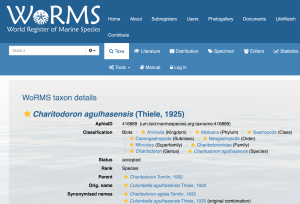Using the WoRMS (via Arctos) source has dramatically reduced the amount of taxonomic work done by the collection administrators. In the past, we were adding many taxa every day. Also, because the classifications in WoRMS (via Arctos) have a unique aphiaID and are automatically updated via webservice, we no longer have to use the Hierarchical Classification Editor to move genera to a different family or make similar changes. And we know that all taxa in a given genus or family have the same higher taxonomy so they can be easily searched.
But there are occasional surprises. The automatic update of WoRMS (via Arctos) means that a genus may have been moved to a new family without us being aware of the change. For example, we were rearranging our Mitridae family and couldn’t find an entry for our specimens of Charitodoron agulhasensis that we labeled in 2017. That genus had been recently moved to a new family Charitodoronidae Fedosovc, Herrmann, Kantos & Bouchet, 2018. So keeping our specimens in the exact same organization as our Arctos database is an ongoing task.
Arctos can add additional local sources, links to webservices or a unique taxa database developed by a participating institution. We are in the process of adding classifications from the Paleobiology Database to the Arctos taxonomy source and eventually may be able to add the WoRMS-like functionality of updating them via the PBDB taxon ID.
